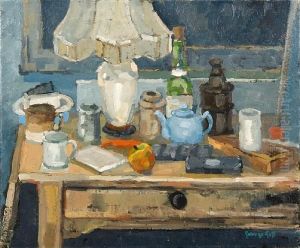George Reynold Gill Paintings
George Reynold Gill was a British portrait painter and photographer, born in 1828. His life and career spanned the 19th century, a period rich in artistic evolution, during which Gill made his mark primarily through his portrait works. While not as widely recognized today as some of his contemporaries, Gill's contributions to Victorian art and early photography offer a fascinating glimpse into the era's cultural and technological advancements.
Gill began his artistic career as a painter, focusing on portraits. His work captured the essence of Victorian society, detailing the period's fashion, attitudes, and aesthetics. He had the ability to portray his subjects with a realism and sensitivity that brought out their individual personalities, making his portraits sought after by the elite of the time. This was a period when portrait painting was highly valued for its ability to immortalize the subject, serving both personal and familial remembrance purposes.
As the 19th century progressed, Gill became interested in the emerging field of photography. This new medium fascinated many artists of the time, as it offered a revolutionary way to capture images with precision and speed previously unattainable. Gill embraced photography, integrating it into his artistic practice. He saw it not just as a technical innovation but as a new form of art that could complement traditional painting techniques. His work in photography, particularly in portrait photography, was notable for its clarity and depth, qualities that mirrored his painted portraits.
Throughout his career, George Reynold Gill navigated the intersection of art and technology with a forward-thinking approach. He was part of a generation of artists who were early adopters of photography, recognizing its potential to transform visual culture. Despite the prominence of other figures in Victorian art and the overshadowing fame of photographers in the subsequent eras, Gill's dual legacy as a painter and photographer remains an interesting chapter in the history of 19th-century British art.
Gill's death in 1901 marked the end of an era and the career of an artist who had contributed to the rich tapestry of Victorian visual culture. While specific details about his life and works are less documented than those of his more famous peers, George Reynold Gill's artistic endeavors offer valuable insights into the blending of traditional and emerging art forms during a pivotal period in history.
